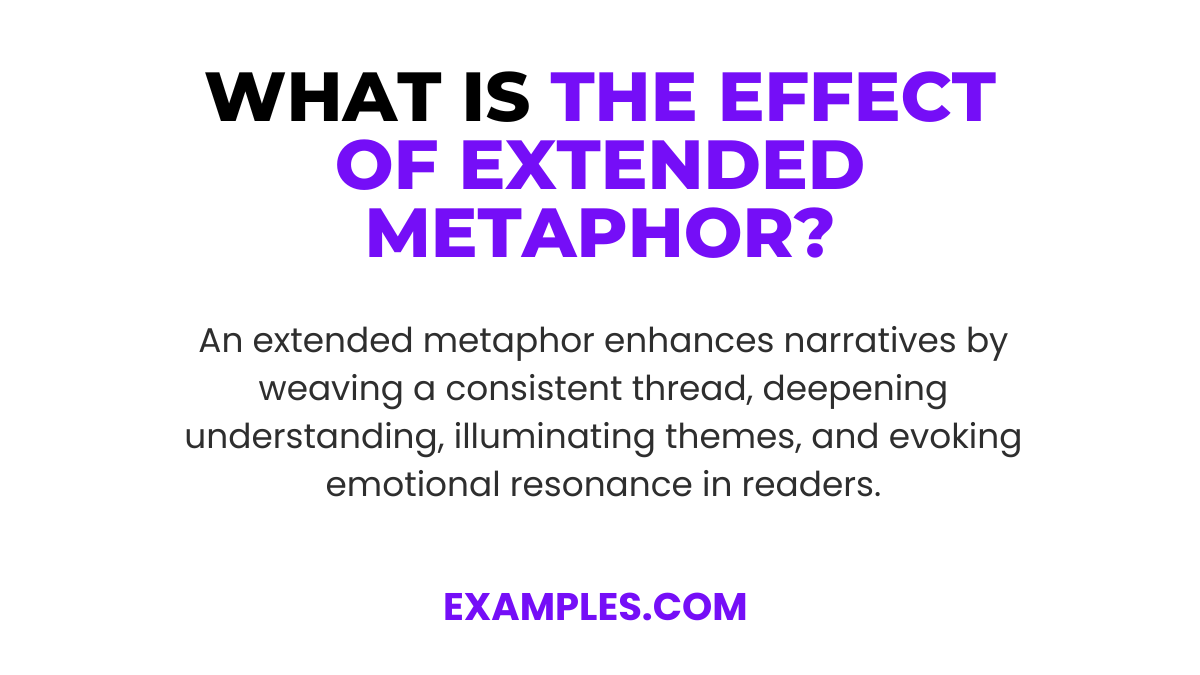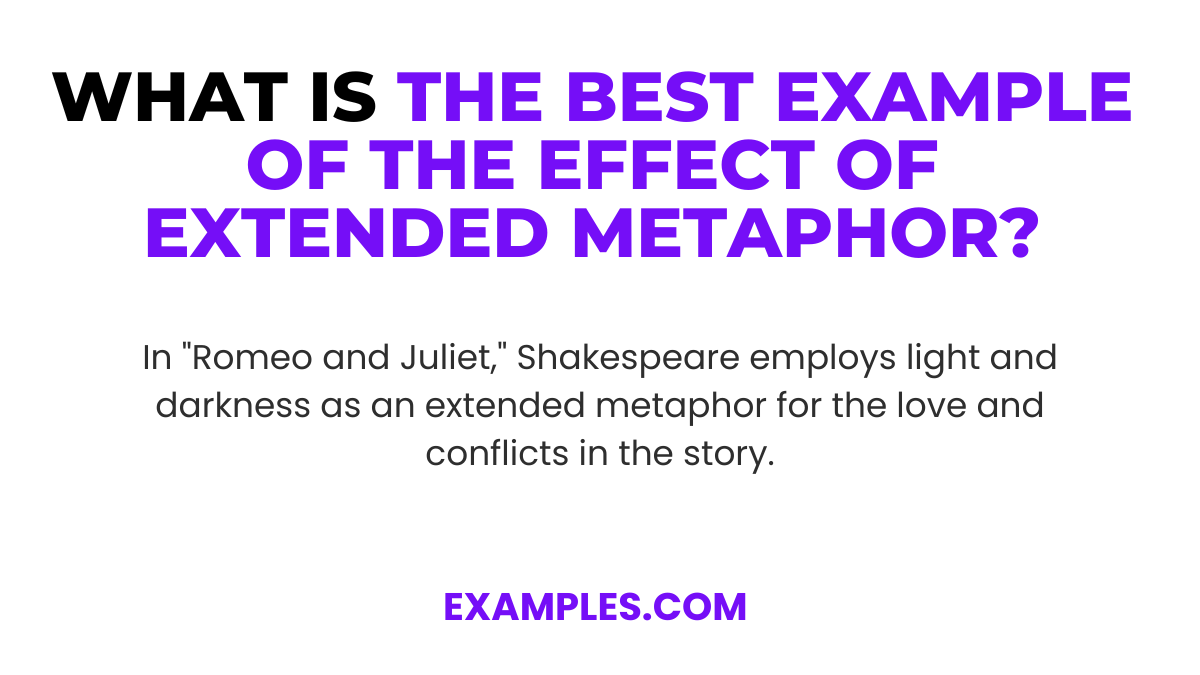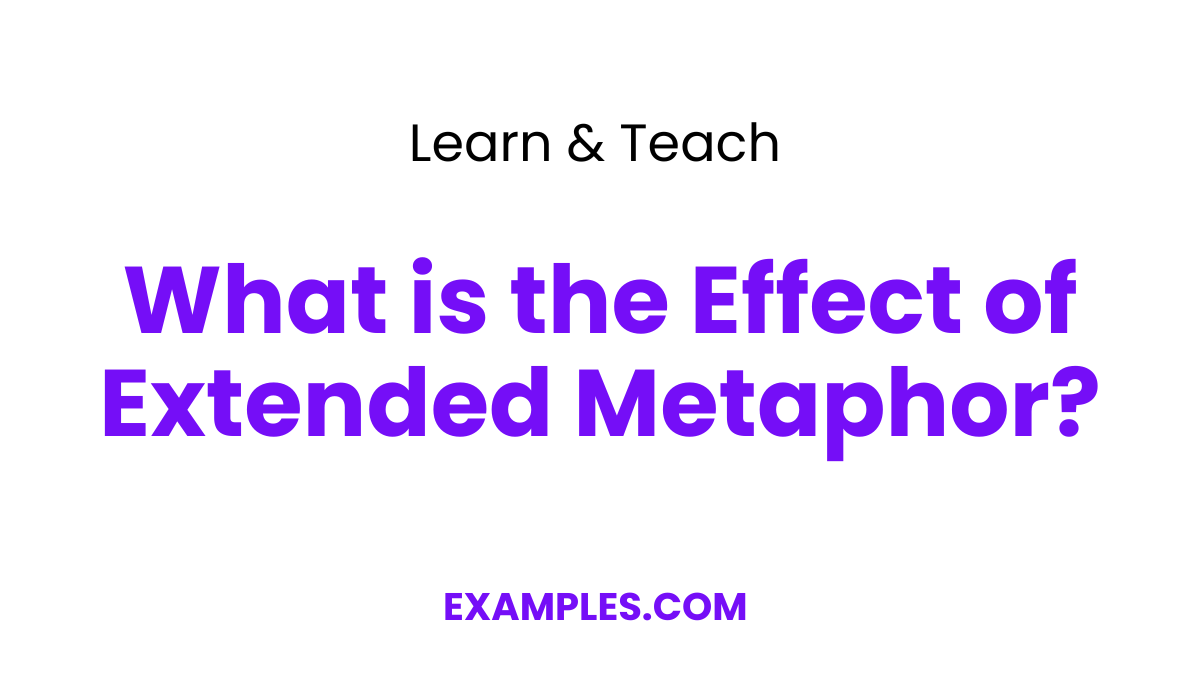What is the Effect of Extended Metaphor?
Extended metaphors are a powerful literary device, capable of adding profound depth and complexity to writing. They allow authors to stretch a single metaphor throughout a part or the entirety of a narrative, creating a cohesive and resonant theme. This guide explores how to craft effective extended metaphors, their impact on storytelling, and practical tips for integrating them into your writing. Learn to harness this tool to enrich your narrative and engage your audience deeply.
What is the Effect of Extended Metaphor?

The effect of an extended metaphor is multifaceted. It enriches a narrative by providing a consistent thread that ties various elements together, offering readers a deeper level of understanding and engagement. Extended metaphors can illuminate themes, enhance character development, and provide symbolic resonance to the story. They encourage readers to think critically, drawing parallels between the metaphor and the underlying message or theme. This literary device can also evoke stronger emotional responses, making the narrative more memorable and impactful.
What is the Best Example of the Effect of Extended Metaphor?

A prime example of the effect of an extended metaphor is seen in Shakespeare’s play “Romeo and Juliet.” Throughout the play, Shakespeare uses light and darkness as an extended metaphor for the love between Romeo and Juliet, as well as the contrasting forces that surround their relationship. This metaphor enhances the thematic depth of the play, illustrating the intensity and danger of their forbidden love, and the societal constraints that envelop them. The light and darkness metaphor subtly weaves through the dialogue and scenes, enriching the narrative and amplifying its emotional impact.
What is the Effect of Extended Metaphor in Poetry?
Extended metaphors in poetry create a powerful connection between the metaphor and the reader, enriching the poem’s thematic depth. These literary devices enable poets to develop complex themes and emotions, offering a more immersive and reflective reading experience. Keywords: extended metaphor, poetry, thematic depth, emotional resonance, literary devices.
- “The Road Not Taken” by Robert Frost: The paths in the forest symbolize life choices. Frost’s extended metaphor invites readers to reflect on the impact of decisions and the roads not taken in life.
- “Hope is the thing with feathers” by Emily Dickinson: Here, hope is compared to a bird. Dickinson’s metaphor extends throughout the poem, portraying hope as an enduring and comforting presence.
- “Mother to Son” by Langston Hughes: The staircase represents life’s journey. Hughes uses this metaphor to depict the struggles and perseverance inherent in life, especially in the context of racial inequality.
- “O Captain! My Captain!” by Walt Whitman: The ship and captain symbolize Abraham Lincoln and the Civil War. Whitman extends this metaphor to capture the nation’s grief and the cost of victory.
- “The Raven” by Edgar Allan Poe: The raven represents grief and loss. Poe’s use of this metaphor creates a haunting atmosphere, embodying the speaker’s descent into despair.
- “Mending Wall” by Robert Frost: The wall is a metaphor for barriers between people. Frost extends this idea to question the necessity and impact of such divisions.
- “My Life had stood – a Loaded Gun” by Emily Dickinson: The gun symbolizes the speaker’s life and potential. Dickinson extends this metaphor to explore themes of power and identity.
- “The Flea” by John Donne: A flea becomes a metaphor for physical intimacy. Donne ingeniously extends this metaphor to argue against societal norms of his time.
- “Mirror” by Sylvia Plath: The mirror symbolizes truth and self-reflection. Plath’s metaphor extends to explore themes of identity, aging, and self-perception.
- “Because I could not stop for Death” by Emily Dickinson: Death is personified as a carriage driver. Dickinson extends this metaphor to explore mortality and the journey beyond life.
What is the Effect of Extended Metaphor in Literature?
Extended metaphors in literature serve as a powerful narrative tool, providing depth and layers to the storytelling. They enable writers to draw intricate parallels between characters and themes, enriching the reader’s understanding and engagement. Keywords: extended metaphor, narrative tool, literary storytelling, character development, thematic parallels.
- “To Kill a Mockingbird” by Harper Lee: The mockingbird represents innocence and goodness. Lee uses this metaphor throughout the novel to highlight the destruction of innocence and the moral call to protect it.
- “Animal Farm” by George Orwell: The farm is a metaphor for Soviet Russia. Orwell extends this metaphor to critique totalitarianism and the corruption of socialist ideals.
- “The Great Gatsby” by F. Scott Fitzgerald: The green light symbolizes Gatsby’s unattainable dreams. Fitzgerald’s extended metaphor reflects on the American Dream and its elusive nature.
- “Moby-Dick” by Herman Melville: The white whale is a metaphor for obsession. Melville uses this to explore the destructive nature of vengeance and the human condition.
- “1984” by George Orwell: Big Brother symbolizes government surveillance. Orwell extends this metaphor to discuss the dangers of totalitarianism and loss of personal freedom.
- “Lord of the Flies” by William Golding: The island represents a microcosm of society. Golding’s metaphor is extended to examine human nature and the breakdown of civilization.
- “The Scarlet Letter” by Nathaniel Hawthorne: The scarlet letter is a metaphor for societal judgment and penance. Hawthorne uses it to critique puritanical norms and the nature of sin and redemption.
- “Heart of Darkness” by Joseph Conrad: The Congo River symbolizes the journey into the unknown. Conrad’s extended metaphor examines imperialism and the darkness within the human psyche.
- “The Bell Jar” by Sylvia Plath: The bell jar is a metaphor for mental illness and confinement. Plath extends this to explore the struggles of a woman against societal expectations.
- “Frankenstein” by Mary Shelley: The monster is a metaphor for scientific hubris and isolation. Shelley uses this metaphor to delve into themes of creation, responsibility, and societal rejection.
What is the Effect of Extended Metaphor Essay?
In essays, extended metaphors are used to draw powerful connections between the subject and broader themes, enhancing the argument or narrative. They provide depth, clarity, and a memorable framework to the essay’s ideas. Keywords: extended metaphor, essay writing, thematic enhancement, narrative depth, argument clarity.
- Martin Luther King Jr.’s “I Have a Dream” speech: King uses various metaphors, like a “bad check,” to represent racial injustice. He extends these metaphors to reinforce his vision for equality and freedom.
- “Self-Reliance” by Ralph Waldo Emerson: Emerson uses the metaphor of a journey to represent individualism. This extended metaphor underpins his essay on the importance of self-reliance and personal integrity.
- “The Myth of Sisyphus” by Albert Camus: Sisyphus’s eternal struggle is a metaphor for human existence. Camus extends this to explore themes of absurdity and finding meaning in life.
- “A Room of One’s Own” by Virginia Woolf: A room symbolizes women’s need for personal and creative space. Woolf extends this metaphor to advocate for women’s independence and intellectual freedom.
- “Letter from Birmingham Jail” by Martin Luther King Jr.: King uses the metaphor of a “network of mutuality” to describe social interconnectedness. He extends this to argue for collective responsibility in combating injustice.
- “Shooting an Elephant” by George Orwell: The elephant represents colonialism and Orwell’s moral dilemma. This metaphor is extended to critique imperialism and the individual’s role within it.
- “The Fire Next Time” by James Baldwin: Baldwin uses fire as a metaphor for racial tension. He extends this to discuss the consequences of racial injustice and the potential for societal transformation.
- “Consider the Lobster” by David Foster Wallace: The lobster is a metaphor for ethical consumption. Wallace extends this to question the morality of eating sentient beings.
- “Notes of a Native Son” by James Baldwin: Baldwin uses various metaphors to explore racial identity. These are extended to offer insights into African American experiences and broader societal issues.
- “The Death of the Moth” by Virginia Woolf: The moth’s struggle symbolizes life’s fragility. Woolf extends this metaphor to reflect on the nature of existence and the inevitability of death.
Extended metaphors are a powerful literary technique, enriching poetry, literature, and essays by weaving complex thematic threads. They add depth, enhance understanding, and evoke emotional responses, making narratives more engaging and memorable. These examples illustrate how extended metaphors can be effectively used to deepen meaning, highlight themes, and create a lasting impact on the reader’s experience.



